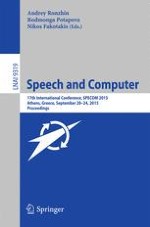2015 | OriginalPaper | Buchkapitel
Fast Algorithm for Precise Estimation of Fundamental Frequency on Short Time Intervals
verfasst von : Andrey Barabanov, Alexandr Melnikov, Valentin Magerkin, Evgenij Vikulov
Erschienen in: Speech and Computer
Aktivieren Sie unsere intelligente Suche, um passende Fachinhalte oder Patente zu finden.
Wählen Sie Textabschnitte aus um mit Künstlicher Intelligenz passenden Patente zu finden. powered by
Markieren Sie Textabschnitte, um KI-gestützt weitere passende Inhalte zu finden. powered by
